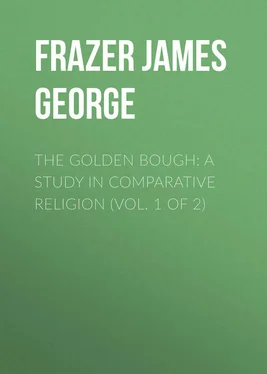James Frazer - The Golden Bough - A Study in Comparative Religion (Vol. 1 of 2)
Здесь есть возможность читать онлайн «James Frazer - The Golden Bough - A Study in Comparative Religion (Vol. 1 of 2)» — ознакомительный отрывок электронной книги совершенно бесплатно, а после прочтения отрывка купить полную версию. В некоторых случаях можно слушать аудио, скачать через торрент в формате fb2 и присутствует краткое содержание. Жанр: foreign_religion, foreign_antique, foreign_prose, на английском языке. Описание произведения, (предисловие) а так же отзывы посетителей доступны на портале библиотеки ЛибКат.
- Название:The Golden Bough: A Study in Comparative Religion (Vol. 1 of 2)
- Автор:
- Жанр:
- Год:неизвестен
- ISBN:нет данных
- Рейтинг книги:4 / 5. Голосов: 1
-
Избранное:Добавить в избранное
- Отзывы:
-
Ваша оценка:
- 80
- 1
- 2
- 3
- 4
- 5
The Golden Bough: A Study in Comparative Religion (Vol. 1 of 2): краткое содержание, описание и аннотация
Предлагаем к чтению аннотацию, описание, краткое содержание или предисловие (зависит от того, что написал сам автор книги «The Golden Bough: A Study in Comparative Religion (Vol. 1 of 2)»). Если вы не нашли необходимую информацию о книге — напишите в комментариях, мы постараемся отыскать её.
The Golden Bough: A Study in Comparative Religion (Vol. 1 of 2) — читать онлайн ознакомительный отрывок
Ниже представлен текст книги, разбитый по страницам. Система сохранения места последней прочитанной страницы, позволяет с удобством читать онлайн бесплатно книгу «The Golden Bough: A Study in Comparative Religion (Vol. 1 of 2)», без необходимости каждый раз заново искать на чём Вы остановились. Поставьте закладку, и сможете в любой момент перейти на страницу, на которой закончили чтение.
Интервал:
Закладка:
In the Moluccas when the clove-trees are in blossom they are treated like pregnant women. No noise must be made near them; no light or fire must be carried past them at night; no one must approach them with his hat on, but must uncover his head. These precautions are observed lest the tree should be frightened and bear no fruit, or should drop its fruit too soon, like the untimely delivery of a woman who has been frightened in her pregnancy. 214 214 Van Schmid, “Aanteekeningen, nopens de zeden, gewoonten en gebruiken, etc., der bevolking van de eilanden Saparoea, etc.” in Tijdschrift v. Neêrland's Indië , 1843, dl. ii. 605; Bastian, Indonesien , i. 156.
So when the paddy (rice) is in bloom the Javanese say it is pregnant and make no noises (fire no guns, etc.) near the field, fearing that if they did so the crop would be all straw and no grain. 215 215 Van Hoëvell, Ambon en meer bepaaldelijk de Oeliasers , p. 62.
In Orissa, also, growing rice is “considered as a pregnant woman, and the same ceremonies are observed with regard to it as in the case of human females.” 216 216 The Indian Antiquary , i. 170.
Conceived as animate, trees are necessarily supposed to feel injuries done to them. When an oak is being felled “it gives a kind of shriekes or groanes, that may be heard a mile off, as if it were the genius of the oake lamenting. E. Wyld, Esq., hath heard it severall times.” 217 217 J. Aubrey, Remaines of Gentilisme , p. 247.
The Ojebways “very seldom cut down green or living trees, from the idea that it puts them to pain, and some of their medicine-men profess to have heard the wailing of the trees under the axe.” 218 218 Peter Jones's History of the Ojebway Indians , p. 104.
Old peasants in some parts of Austria still believe that forest-trees are animate, and will not allow an incision to be made in the bark without special cause; they have heard from their fathers that the tree feels the cut not less than a wounded man his hurt. In felling a tree they beg its pardon. 219 219 A. Peter, Volksthümliches aus Österreichisch-Schlesien , ii. 30.
So in Jarkino the woodman craves pardon of the tree he cuts down. 220 220 Bastian, Indonesien , i. 154; cp. id. , Die Völker des estlichen Asien , ii. 457 sq. , iii. 251 sq. , iv. 42 sq.
Again, when a tree is cut it is thought to bleed. Some Indians dare not cut a certain plant, because there comes out a red juice which they take for the blood of the plant. 221 221 Loubere, Siam , p. 126.
In Samoa there was a grove of trees which no one dared cut. Once some strangers tried to do so, but blood flowed from the tree, and the sacrilegious strangers fell ill and died. 222 222 Turner, Samoa , p. 63.
Till 1855 there was a sacred larch-tree at Nauders, in the Tyrol, which was thought to bleed whenever it was cut; moreover the steel was supposed to penetrate the woodman's body to the same depth that it penetrated the tree, and the wound on the tree and on the man's body healed together. 223 223 Mannhardt, Baumkultus , p. 35 sq.
Sometimes it is the souls of the dead which are believed to animate the trees. The Dieyerie tribe of South Australia regard as very sacred certain trees, which are supposed to be their fathers transformed; hence they will not cut the trees down, and protest against the settlers doing so. 224 224 Native Tribes of South Australia , p. 280.
Some of the Philippine Islanders believe that the souls of their forefathers are in certain trees, which they therefore spare. If obliged to fell one of these trees they excuse themselves to it by saying that it was the priest who made them fell it. 225 225 Blumentritt, “Der Ahnencultus und die religiösen Anschauungen der Malaien des Philippinen-Archipels,” in Mittheilungen der Wiener Geogr. Gesellschaft , 1882, p. 165 sq.
In an Annamite story an old fisherman makes an incision in the trunk of a tree which has drifted ashore; but blood flows from the cut, and it appears that an empress with her three daughters, who had been cast into the sea, are embodied in the tree. 226 226 Landes, “Contes et légendes annamites,” No. 9, in Cochinchine Française, Excursions et Reconnaissances , No. 20, p. 310.
The story of Polydorus will occur to readers of Virgil.
In these cases the spirit is viewed as incorporate in the tree; it animates the tree and must suffer and die with it. But, according to another and no doubt later view, the tree is not the body, but merely the abode of the tree-spirit, which can quit the injured tree as men quit a dilapidated house. Thus when the Pelew Islanders are felling a tree, they conjure the spirit of the tree to leave it and settle on another. 227 227 Kubary in Bastian's Allerlei aus Mensch-und Volkenkunde , i. 52.
The Pádams of Assam think that when a child is lost it has been stolen by the spirits of the wood. So they retaliate on the spirits by cutting down trees till they find the child. The spirits, fearing to be left without a tree in which to lodge, give up the child, and it is found in the fork of a tree. 228 228 Dalton, Ethnology of Bengal , p. 25; Bastian, Volkerstämme am Brahmaputra , p. 37.
Before the Katodis fell a forest-tree, they choose a tree of the same kind and worship it by presenting a cocoa-nut, burning incense, applying a red pigment, and begging it to bless the undertaking. 229 229 Journal R. Asiatic Society , vii. (1843) 29.
The intention, perhaps, is to induce the spirit of the former tree to shift its quarters to the latter. In clearing a wood, a Galeleze must not cut down the last tree till the spirit in it has been induced to go away. 230 230 Bastian, Indonesien , i. 17.
The Mundaris have sacred groves which were left standing when the land was cleared, lest the sylvan gods, disquieted at the felling of the trees, should abandon the place. 231 231 Dalton, Ethnology of Bengal , pp. 186, 188; cp. Bastian, Volkerstämme am Brahmaputra , p. 9.
The Miris in Assam are unwilling to break up new land for cultivation so long as there is fallow land available; for they fear to offend the spirits of the woods by cutting down trees unnecessarily. 232 232 Dalton, op. cit. p. 33; Bastian, op. cit. p. 16. Cp. W. Robertson Smith, The Religion of the Semites , i. 125.
In Sumatra, so soon as a tree is felled, a young tree is planted on the stump; and some betel and a few small coins are also placed on it. 233 233 Van Hasselt, Volksbeschrijving van Midden-Sumatra , p. 156.
Here the purpose is unmistakable. The spirit of the tree is offered a new home in the young tree planted on the stump of the old one, and the offering of betel and money is meant to compensate him for the disturbance he has suffered. So in the island of Chedooba, on felling a large tree, one of the woodmen was always ready with a green sprig, which he ran and placed on the middle of the stump the instant the tree fell. 234 234 Handbook of Folk-lore , p. 19 (proof).
For the same purpose German woodmen make a cross upon the stump while the tree is falling, in the belief that this enables the spirit of the tree to live upon the stump. 235 235 Mannhardt, Baumkultus , p. 83.
Thus the tree is regarded, sometimes as the body, sometimes as merely the house of the tree-spirit; and when we read of sacred trees which may not be cut down because they are the seat of spirits, it is not always possible to say with certainty in which way the presence of the spirit in the tree is conceived. In the following cases, perhaps, the trees are conceived as the dwelling-place of the spirits rather than as their bodies. The old Prussians, it is said, believed that gods inhabited high trees, such as oaks, from which they gave audible answers to inquirers; hence these trees were not felled, but worshipped as the homes of divinities. 236 236 Erasmus Stella, “De Borussiae antiquitatibus,” in Novus Orbis regionum ac insularum veteribus incognitarum , p. 510; Lasiczki (Lasicius), “De diis Samagitarum caeterorumque Sarmatarum,” in Respublica sive Status Regni Poloniae, Lituaniae, Prussiae, Livoniae , etc. (Elzevir, 1627), p. 299 sq. There is a good and cheap reprint of Lasiczki's work by W. Mannhardt in Magazin herausgegeben von der Lettisch-Literarischen Gesellschaft , xiv. 82 sqq. (Mitau, 1868).
The great oak at Romove was the especial dwelling-place of the god; it was veiled with a cloth, which was, however, removed to allow worshippers to see the sacred tree. 237 237 Simon Grünau, Preussische Chronik , ed. Perlbach (Leipzig 1876), p. 89; “Prisca antiquorum Prutenorum religio,” in Respublica sive Status Regni Poloniae etc., p. 321.
The Battas of Sumatra have been known to refuse to cut down certain trees because they were the abode of mighty spirits which would resent the injury. 238 238 B. Hagen, “Beiträge zur Kenntniss der Battareligion,” in Tijdschrift voor Indische Taal- Land- en Volkenkunde , xxviii. 530 note .
The Curka Coles of India believe that the tops of trees are inhabited by spirits which are disturbed by the cutting down of the trees and will take vengeance. 239 239 Bastian, Die Völker des östlichen Asien , i. 134.
The Samogitians thought that if any one ventured to injure certain groves, or the birds or beasts in them, the spirits would make his hands or feet crooked. 240 240 Matthias Michov, in Novus Orbis regionum ac insularum veteribus incognitarum , p. 457.
Интервал:
Закладка:
Похожие книги на «The Golden Bough: A Study in Comparative Religion (Vol. 1 of 2)»
Представляем Вашему вниманию похожие книги на «The Golden Bough: A Study in Comparative Religion (Vol. 1 of 2)» списком для выбора. Мы отобрали схожую по названию и смыслу литературу в надежде предоставить читателям больше вариантов отыскать новые, интересные, ещё непрочитанные произведения.
Обсуждение, отзывы о книге «The Golden Bough: A Study in Comparative Religion (Vol. 1 of 2)» и просто собственные мнения читателей. Оставьте ваши комментарии, напишите, что Вы думаете о произведении, его смысле или главных героях. Укажите что конкретно понравилось, а что нет, и почему Вы так считаете.












